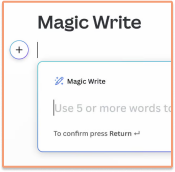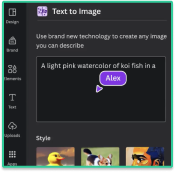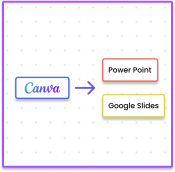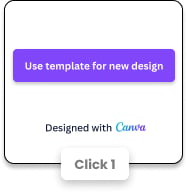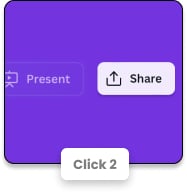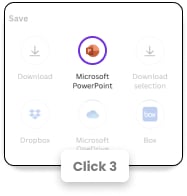Have you ever struggled to pay attention during an online webinar? Or found your colleague harder to follow during a video meeting?
You’re not alone.
If you believe the experts, then just 7% of what we communicate comes from the words we say. Our tone accounts for 38% and body language is responsible for the remaining 55%.
And that’s all well and good when you’re in the room with your audience, but what happens when you’re presenting over the web? In our increasingly remote world of work, this is something we really need to consider…
- Presenting in-person vs. remotely: the key differences
- Keep it simple
- Use contrasting colors and text
- Reduce transitions and animations (or avoid them completely)
- Emphasize key points
- Use a navigator
- Think about tempo
- Ready to take on the remote world?
Presenting in-person vs. remotely: the key differences
Gesturing to a piece of key information, opening your arms to invite a response from your audience, pacing the stage, locking eyes with each person in turn to keep their attention on you — these are just some of the ways body language can enhance your presentation and build trust and rapport with your audience.
Now imagine you don’t have any of that. Imagine that over 50% of your communication is completely shut off. This is what you have to deal with when giving a presentation remotely.
Remote presentations are fast becoming the norm. In fact, up to 80% of corporate presentations are now being delivered remotely — and this was the case even before COVID-19 came along.
More and more businesses are waking up to the fact that working globally does not necessarily require international travel. Now you can run a worldwide organization from a single office!
Delivering an effective remote presentation is a different challenge than nailing the same presentation in person. You need to pay even closer attention to what you are saying, how you are saying it, and — yes, you guessed it — the quality of the slides you are presenting.
You need to think about what types of devices people will be viewing your presentation on and optimize it for all of them. Remember that the potential for people to get distracted is quite high — with the “new tab” button looking increasingly inviting to audience members the longer your presentation goes on.
You don’t want to be just another online presentation, do you?
Of course not!
With that in mind, these are our 6 top tips to help you craft and deliver an awesome remote presentation.
Remote presentations tip: Keep it simple
This one crops up in almost every presentation tip list — and that should tell you something.
Your slides should be designed in such a way that they can communicate key pieces of information at a glance. And remember, they need to do this regardless of what device people are watching on.

How can you do this? Well, first make good use of white space to draw focus to the key points and minimize distractions. Then make sure you only have the bare minimum amount of text on each slide — enough so people could follow along if they don’t have audio (as is sometimes the case if someone has a poor connection), but not so much that they tune out from what you’re saying.
Remote presentations tip: Use contrasting colors and text
Of course, the text on your slides should be clear and easy to read, too. You can achieve that with large, clear fonts, and strong contrasting colors.

You should do this for every presentation, but it is arguably even more important when giving a presentation remotely. Think again about the devices your audience might be using. Tablets and other mobile devices have smaller screens, so nondescript text and bland colors will make the whole thing frustratingly difficult to follow.
Remote presentations tip: Reduce transitions and animations (or avoid them completely)
When giving a presentation in person, transitions and animations can help add some variety to your slides and keep your audience engaged — if used judiciously!
But when giving a remote presentation, there’s another factor to consider: lag. If your audience is connecting over poor WiFi or a mobile network, they will likely experience some lag during your presentation.
Now, a little bit of lag is not going to derail things completely — at least not until you add in a bunch of fancy transitions, text animations, and even the odd gif. Trying to follow all of that on a choppy connection is going to push your presentation from “hard to follow” to “completely unintelligible”.

Your best bet? Get rid of as many moving elements as possible and go all-in on the two points above — simplicity and contrast — to ensure everyone can follow along what you are saying, regardless of connection quality.
Remote presentations tip: Emphasize key points
You should think about ways to emphasize the key points of your presentation without your trusty extendable pointer.
Even in the absence of moving elements, a simple arrow or circle can be helpful in drawing attention to a specific point at a specific time. You could also experiment with different (i.e. larger) text sizes and stand-out colors.

Use these tools alongside the tips above to make important information pop and drive the key points home as best you can.
Remote presentations tip: Use a navigator
A navigator on your presentation usually takes the form of a little slider or progress bar towards the bottom that lets people know how far along you are in the deck.

You can also use a navigator to show the different sections of your presentation and how many slides are in each section. This will help orient your audience and make it even easier for them to follow along.
Remote presentations tip: Think about tempo
When presenting remotely, the slides and your vocal cords are all you have to work with, so those things become even more important than they would be if you were presenting in person.
Visual variation is vital to keeping things interesting for your audience, so vary the layout and structure of your slides — even while maintaining a distinct visual theme.

You should also give careful consideration to when you might want to pause to allow your audience to catch up. Separating your presentation into sections, as mentioned above, is a good way to do this. Pausing at the end of each section will give the information a chance to crystallize in their minds, before you move on to the next section.
Remember: pausing after key points can also increase their impact. So consider adding some presenter notes to remind yourself to take a microbreak every time you drop an info-bomb on your audience.
Ready to take on the remote world?
Remote presentations require special planning and prioritization to be as effective as in-person ones. If you think you can just roll out the same presentation as before, you could end up completely missing the mark.
Your slides need to do so much more of the work than they normally would. The design, colors, layout, images, icons, text, and tempo need to be as close to perfect as you can get.
Sounds like a lot of work, doesn’t it? Well, that’s because it is! Crafting your presentation from scratch is incredibly time-consuming, so you might want to use a template — one that ticks all of the boxes we’ve covered so far.
SlidesCarnival hosts hundreds of carefully thought-out and expertly designed presentation templates for just about any situation imaginable. Browse all our free PowerPoint & Google Slides templates or pick from one of our categories and see which one catches your eye!
Then all you have left to do is practice your dramatic pauses — oh, and remember to change out of your pajamas before hopping on that breakfast meeting call!


